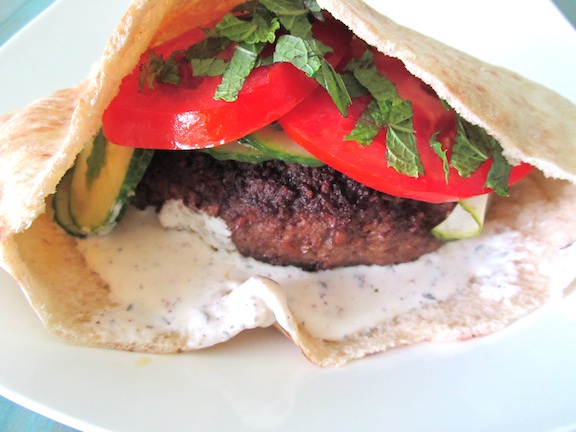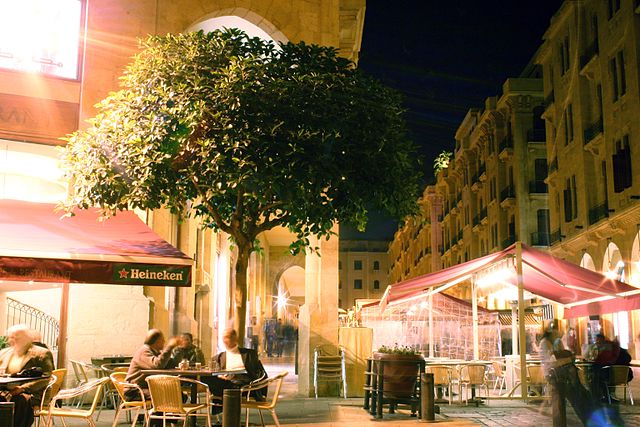
Lamb Kibbeh with Za’atar Spiced Labne
Finally we get to Lebanon and Paul and I have a good excuse to try the Lebanese restaurant that opened a year ago down the street. So we went to Al Wadi, and we feasted…but more about that in a minute. First let’s cover the basics.
Lebanon is a country on the Mediterranean Sea bordered by Syria and Israel. It is an ancient land; in fact the name “Lebanon” has been in use for about 4,000 years making it one of the oldest country names in the world. And the city of Byblos in Lebanon (according to Wikipedia) is the oldest continuously inhabited city in the world. In addition to being home to too many archeological sites to count, Lebanon is also home to a thriving modern society.

“Beirut Downtown” by Bertil Videt – Own work. Licensed under Creative Commons Attribution 2.5 via Wikimedia Commons – http://commons.wikimedia.org/wiki/File:Beirut_Downtown.jpg#mediaviewer/File:Beirut_Downtown.jpg
The population of Lebanon is around 5.9 million people, but the influence of Lebanon goes well beyond that. While it’s impossible to get a completely accurate count, most estimates put the number of Lebanese living outside the country at around 14-15 million. Which brings us back to our local Lebanese restaurant. So our feast began with some basic hommus and baba ghanouj – always a crowd pleaser. We then moved on to more exotic fair and sampled Sfeha (dough filled with meat, onions, peppers and tomato), Makanik (sausage) and, of course some Kibbeh and Kebabs.
So aside from having a good meal, did I learn anything useful about Lebanese food that could inform my own recipe? Not really, if you’ve been paying attention, you know that I really like Middle Eastern food. Lebanese food is pretty classic Middle Eastern, since it’s such an old country, it makes sense that the flavors here would be prototypical. The only note I could find differentiating Lebanese food was a reference to a stronger use of lemon and olive oil than some other Middle Eastern cuisines. Not much to go on, and not noticeable as we dined as Al Wadi, but that’s ok, we’ll figure it out.
So we’ll start with meat – meat and meat products are a huge part of Lebanese cooking. Lamb and chicken are two of the more popular meats, although beef is not uncommon. I decided to stick with lamb because I think it goes best with the flavors of the region, and, we haven’t had lamb in a while, so let’s go with lamb. We haven’t tried kibbeh yet, so lamb kibbeh it is! And the kibbeh will be stuffed with more lamb, raisins, olives and tons of spices – I think you’ll be pleased. We’ll top with a classic tomato salad and some fresh labne. Overall the stuffing is the standout with meaty savory flavors marrying perfectly with the sweet spices and raisin, I could eat it by the bucketful. Adding za’atar and some lemon to the labne brightens and freshens the flavor and cuts the meatiness of the lamb perfectly. It’s a filling yet not heavy dish that will please the whole family.
If you like this, there are a ton of burgers based on similar flavors. Two of my favorites are the Iraqi and Jordanian burgers.
Lebanese Burger Recipe
1 cup bulgher
1 small onion roughly chopped
1 pound ground lamb
¼ teaspoon ground cumin
¼ teaspoon ground cinnamon
¼ teaspoon ground pepper
½ teaspoon dried marjoram
Kibbeh Stuffing (recipe below)
Peanut oil
2 large pita rounds cut in half
Za’atar Spiced Labne (recipe below)
Tomato Salad (recipe below)
Rinse the bulgher and place in a glass bowel. Cover with water with an inch extra of water and let soak for 30 minutes. Drain the bulgher and combine with onion, lamb, cumin, cinnamon, pepper and marjoram. Form four balls from the mixture. Using your thumbs, make an indent into each ball and widen to form a bowl type shape. Scoop in 1-2 Tablespoons of stuffing into each bowl then stretch the meat to cover the stuffing so you end up with a ball again. Gently press each ball into a slightly oblong patty. In a large non-stick pan, add peanut oil to about ¼ inch depth. Heat to shimmering. Cook patties in the hot oil until lamb is cooked through.
To serve, warm the pita bread in a 200°F oven for about 5 minutes. Gently pry open the bread. Scoop the Za’atar Spiced Labne inside each pita, then add the cooked patties and top with the tomato salad.
Kibbeh Stuffing
2 Tablespoons pine nuts
1 Tablespoon olive oil
1 small onion finely chopped
1 clove of garlic minced
6 ounces ground lamb
¼ teaspoon ground cumin
¼ teaspoon ground allspice
½ teaspoon ground cinnamon
¼ teaspoon kosher salt
¼ teaspoon ground black pepper
½ teaspoon ground sumac
3 Tablespoons golden raisins
6 kalamata olives finely chopped
In a non-stick skillet, toast the pine nuts until fragrant and glistening. Remove pine nuts from pan. Add olive oil to pan along with onions and garlic. Cook over medium heat for 3 minutes. Add lamb and spices (from cumin to sumac) and cook over medium high for another 5 minutes. Add the raisins and olives and cook for another 5 minutes. Cool slightly before use.
Za’atar Spiced Labne
8 ounces labne
1 Tablespoon za’atar
½ teaspoon kosher salt
Zest of one lemon
Combine all ingredients in a glass bowl, cover and refrigerate until ready to use.
Tomato Salad
1 large tomato sliced super thin
1/3 of an English cucumber sliced thin (use a mandoline if you have one)
3 Tablespoons olive oil
Juice of 2 lemons
2 Tablespoons chopped fresh mint
Place all ingredients in a glass bowl, cover and set aside until ready to use.
https://burgershereandthere.com/?p=1682
©Copyright 2014 Linda Monach





Of course Lebanon has its own quite glorious cuisine, but it has been a victim of its own success, almost being TOO influential on the Middle Eastern palates. This leads many people to believe Lebanese food to be a generic form of “Middle Eastern cuisine”.
Think you are right about the lemon juice. Lebanese flavours are sometimes very very tart and there’s also a penchant for bitterness (like in the ever-present tahini). The internationally reknowned Lebanese standards (falafel-hummus-taboulleh-shawarma-etc) is just the tip of a huge variety of food from this small nation. Much of it is seamlessly adapted to our modern age, fast-cooked, developed in and adapted to busy urban restaurant kitchens. Super freakin healthy as well with it’s endless vegetable variatons. I dig it.